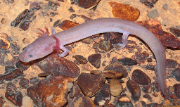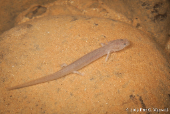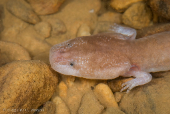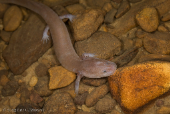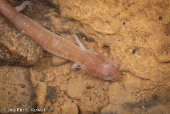 |
Pale Salamander Range Map
|
|
|
 |
 |
 |
 |
 |
 |
|
Pale Salamander (Gyrinophilus palleucus palleucus)
Description: Adults are 100 to 230 mm TL and have 17 to 19 costal grooves. Most individuals do not exceed 100 mm SVL. This species has a stout body, reduced black eyes, a broad head, and a truncated snout (Petranka 1998). Its gills are long, bright red, and tend to curl upward and forward over the head. The tail is oar-like and compressed laterally. The skin is generally translucent and sparsely pigmented, appearing pinkish to flesh-colored from underlying blood capillaries, depending on the subspecies (G. p. palleucus is pale while G. p. necturoides is dark). There may also be tannish-gray pigmentation and spots dorsally and laterally
Habitat: Adults have been found in caves with streams, rimstone pools, stream runs and pools, and pools isolated by receding water. Substrates can be rock, gravel, sand, or mud. Water is usually clear and free of sediment. Sinkholes are an important habitat component because they allow detritus inflow, which sustains large invertebrate populations.
Range: G. p. palleucus inhabits caves in the Crow Creek drainage system of the Lower Tennessee River watershed of Franklin Co., TN and Jackson Co., AL
Found in these States:
AL |
GA |
TN
Diet: Stomach contents of 19 specimens from several caves included oligochaetes, amphipods, isopods, crayfish, cladocerans, beetles, stoneflies, mayflies, dipterans, caddisflies, thrips, and two conspecific salamanders. Amphipods made up 21% of the prey items. It was reported that isopods were a common prey item, and that occasionally salamanders being handled would regurgitate epigean (relatively surface-dwelling) invertebrate prey such as earthworms and coleopteran larvae.
Reproduction: The breeding season is not known. It is suggested that females have irregular breeding patterns and may skip one or more years between breeding. It is also suggested that females oviposit in autumn or early winter, based on discovery of small hatchlings on December 21 and February 15. Eggs have never been found and its nesting biology is unknown. Growth rates are probably slow and larvae may take many years to become sexually mature. All specimens of G. p. palleucus greater than 70 mm SVL are sexually mature
Status: Listed as Near Threatened because its extent of occurrence (EOO) is 28,152 km2, it occurs in 10 or fewer threat-defined locations, and there is continuing decline in the extent and quality of its habitat, thus making the species close to qualifying for Vulnerable.
»» Kingdom: Animalia - Animals
»» Phylum: Chordata - Chordates
»» Subphylum: Vertebrata - Vertebrates
»» Class: Amphibia - (Amphibians)
»» Order: Caudata - Salamanders
»» Family: Plethodontidae - Lungless Salamanders
»» Genus: Gyrinophilus
»» Species: Gyrinophilus palleucus - Tennessee Cave Salamander
»» Subspecies: Gyrinophilus palleucus palleucus - Pale Salamander
This article uses material from the Wikipedia article "Tennessee Cave Salamander", which is released under the Creative Commons Attribution-Share-Alike License 3.0. Content may have been omitted from the original, but no content has been changed or extended.
|
|





